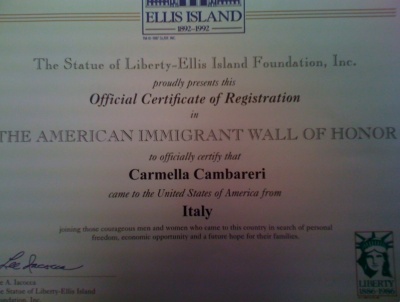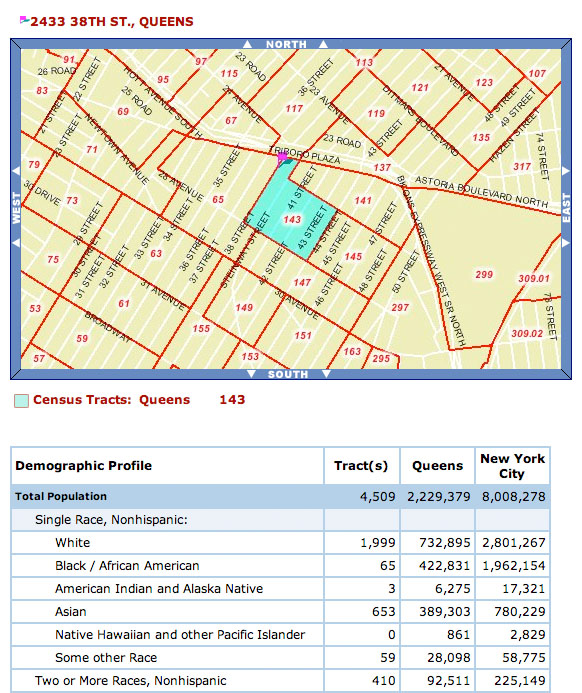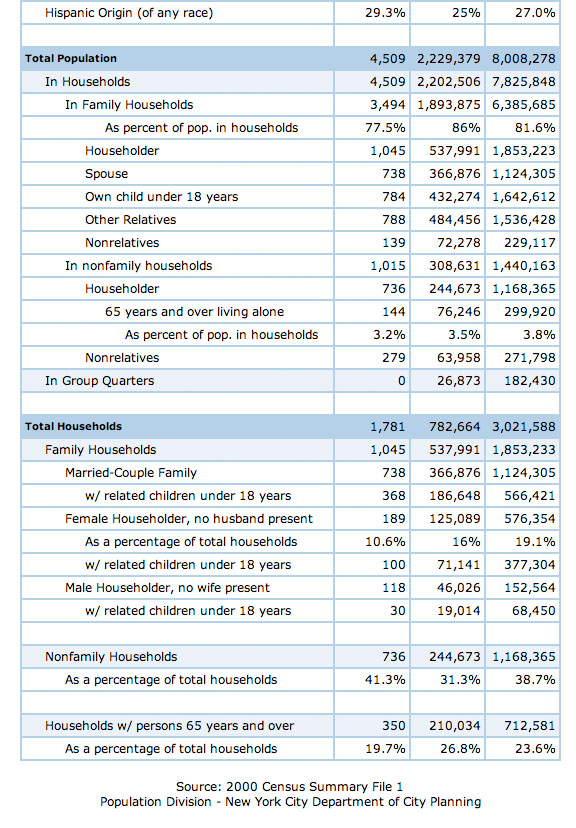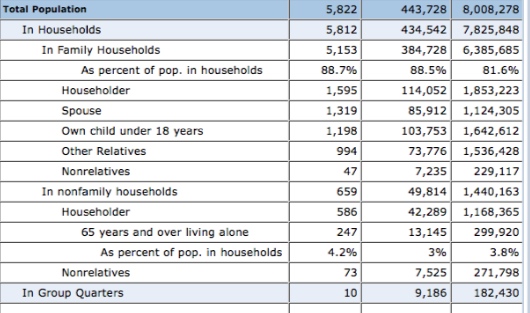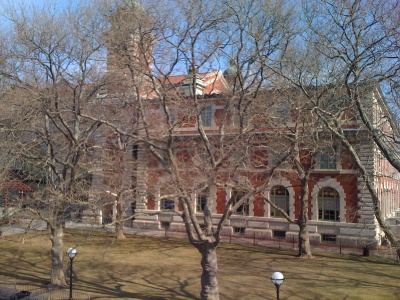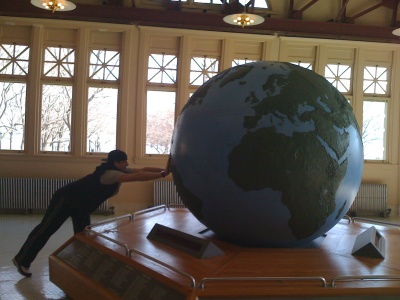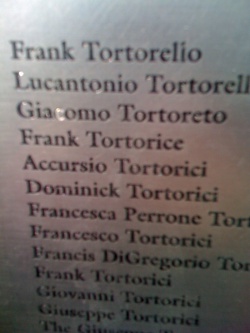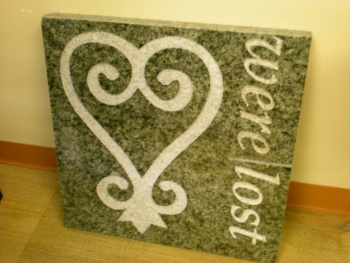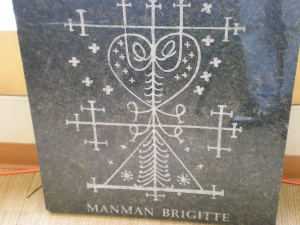From The Peopling of New York City
Contents |
Vincent Tortorice
About Me
My name is Vincent Richard Tortorice. I am currently eighteen years old and my birthday is March 30th, 1990. Ever since I could speak I have used the same three words to describe myself to others. These words not only tell who I am, they convey the very things that get me through everyday life. These three vital aspects of my life are family, friends, and sports.
 Friends and girlfriends come and go, but family will be there forever. Ever since I can remember I have lived my life according to this statement. I am also very proud that my family and I are Italian. A great line from The Godfather is "Never go against the family." Life wouldn’t have been the same without the Italian customs throughout my childhood. Whether it was dinner at grandma’s house or swapping stories, it was here that I learned family values.
Friends and girlfriends come and go, but family will be there forever. Ever since I can remember I have lived my life according to this statement. I am also very proud that my family and I are Italian. A great line from The Godfather is "Never go against the family." Life wouldn’t have been the same without the Italian customs throughout my childhood. Whether it was dinner at grandma’s house or swapping stories, it was here that I learned family values.
Sports have been a part of my life since the day I was born. My parents tell me that I was born with a catcher’s mitt in my hand. This is true because that was my first toy, a baby catcher’s mitt and a squishy, childproof ball. Not only baseball, all sports have been in my blood forever. I get my athleticism and love for sports from my father. He was quite the athlete as a teenager.
I am a very religious person and use my faith in God to get me through tough times in my life. To represent Christianity and my faith I wear a cross given to me by my mother at a very young age. I believe that faith can get one through anything, even the most challenging parts of one's life. I know this from experience. My family and I have religious pieces all over the house and even in all of the cars we own. For example, each car is equipped with a prayer card and a set of rosary beads around the rear view mirror to protect us while driving.
I hope this introduction helps to reveal who I am not only as a fellow classmate and student, but also as a person. I take pride in who I am and am not afraid to tell the world what makes me tick.
Ideal Community
Image from Google Images
Everyone has their own interpretation of the “ideal community” they wish they lived in. We each put the things we desire most in this community, close our eyes and hope they will magically appear. What most people don’t realize is that the ideal community doesn’t have to consist of great wealth and fancy cars to be euphoric. The word community itself means a group of people living together in one place, esp. one practicing common ownership.
An ideal community in my opinion would consist of citizens that cared about the well being of one another, similar to that of a family. For example, if an elderly woman were struggling to bring groceries into her home from her car, a young, more capable neighbor would go out of his way to help her. A selfish community is an unhappy community. Money wouldn't be an issue. Everyone would have more than enough money to support those who lived in the household. Everyone would know each others' names and always greet them on a first name basis. Every weekend the community would throw a block party to celebrate the relationship they have with one another, and to have fun.
Immigration Film Clip
(Interval 6:18-7:55 is the part that that is relevant to immigration)As most of us already know, the movie Titanic, is about the doomed ocean-liner that sank on April 15th, 1912. This epic film is also about a love story that doesn’t necessarily have a “happy ending.” Titanic is not only about the historical account of this tragic event, it also covers immigration into the United States.
At the end of the movie, Rose loses her newfound lover, Jack Dawson to the icy waters of the Atlantic. After she is rescued, she finds herself alone and hopeless. The rescue boat takes the survivors of this terrible incident to Ellis Island. It is here that Rose gains a sense of hope and a “fresh start” in a new country. When the sailor asks Rose her name to record on a clipboard she replies, “Dawson, Rose Dawson.” For those who don’t know, Rose’s actual name is Rose DeWitt Bukater. When she arrives to Ellis Island, much like many other immigrants arriving here, she changes her identity and starts a new chapter of her life. With the sight of the Statue of Liberty, her hopeless spirit has been rejuvenated and restored.
This is very similar to the millions of immigrants who entered the Unites States through this immigration checkpoint. Many immigrants referred to this place at the “Island of Tears.” This may seem contrary to the general understanding because people came to the United States for new and better lives. What many people don’t understand is that men, women, and children were separated from one another breaking up families, sometimes forever. Also, many people lost their identity on this island. They were solely looked at as a number representing their place in the immigration line. Not all immigrants, however, referred to Ellis Island as the “Island of Tears,” for most it was called the “Island of Dreams.” According to statistics, 90% of immigrants were able to leave the island successfully starting new lives. This is similar to what happened to Rose Dawson at the end of Titanic. The Statue of Liberty gave her hope and strength to survive the ordeals of losing a lover and the tragic sinking of the doomed vessel.
Klass Notes
People migrated for + values, resources, pull factors.
The trails that were followed by the Native Americans had a prior history.
These trails were Buffalo trails, hence Buffalo, New York.
Ocean currents and wind were natural factors that most likely led to the early settling of New York.
Economic, people, weather, fish, and a homey feeling were also contributing factors to the settling and migration to New York.
Social reasons for coming to NYC: • People similar to other people • Education because of major universities of higher education • Entertainment (Museums, art, theater) • Shopping Mecca • Lifestyle • Food
Push Factors (from your original home): • Poverty • Religious Persecution • Boredom • Politics • European Wars • Great Depression
Presentation:
Inventory Images – photography still images, moving images Sample surveys Whole material – selecting Field trips There to here essays Books Census data Mapping
Class wiki – DATE MAY 14 @ 6-8 PM at MHC 1) Intro – Vinny Group Rep – Vinny - handout - introduce the field trips → introduce families (stereotypical family stories) o Italians (Ellis Island) – Valentino o Irish (Tenement Museum) – Calahan o African (African Burial Ground) – Senkofa
2) NPS – Margot’s group a. Italians (Ellis Island/Castle) – Valentino b. Irish (Tenement Museum) – Calahan c. African (African Burial Ground) – Senkofa
3) Research – Alisa’s group a. Stats b. Graphs c. Books – bring in fams
4) Media – Danny’s group a. New immigration video
Odd vital jobs Closing – Daniel
Overall Design – Emily, Anna - Navigation/easy clicking - aesthetics
Proofread – Christian
http://macaulay.cuny.edu/seminars/krase09/index.php/Krase%27s_Klass
Send Anna all media to form the structure and design of the wiki.
From There to Here
This is my great grandmother, Carmella Cambareri's, official Certificate of Registration from Ellis Island
Their journey from there to here surely wasn’t an easy one. They battled the terrible living conditions on the long boat ride here and a rigorous process making them finally part of America. Of course I speak of the hundreds of thousands of immigrants who came from places all over the world. The amount of respect I have for these great people cannot be put into words and I am proud to say I am a direct descendent of four of these people.
Mary Piccolo, Nichol Apicello, Dominick Cambareri, and Carmella Dimare are the names of four of the greatest Italian immigrants to pass through that historic island called Ellis. These are the names of my four great grandparents who came from Naples and Genoa, Italy. It was here, through these four immigrants that the Italian customs and traditions I still practice to this day were brought from the mother country of Italy to a new place, America. This treacherous journey from their home country was not an easy one and in some cases was filled with disappointment and sorrow. Luckily, my great grandparents were able to plant their roots in America and flourish as Italian American citizens of this great country. In times of hardship I think of their story and how they persevered together to overcome anything thrown their way. They used their strong Italian pride and unity along with faith to overcome all obstacles, whether it was cramped living conditions or struggling to find a job to support a family of five.
Unfortunately, I was not able to speak to my great grandparents directly, but I feel my living ancestors, my parents and grandmother, gave me an accurate account of their stories. My grandmother would always tell me how much I would’ve loved my great grandparents because of their strong Italian beliefs. My parents went on to tell me how Dominick and Nichol, my great grandfathers, found low paying jobs for unbelievably long hours to support their families in a new place. Dominick was a carpenter and Nichol was a construction worker. They both worked long hours for very low wages, but they knew it was something they had to do to ensure the survival of their families. This is a perfect example of the Italian pride and determination to succeed. Starting from the bottom of the occupational ladder working up, Italians worked jobs such as shoe shinning, sewer cleaning, and whatever hard, dirty, dangerous jobs others didn't want. Mary and Carmella, my great grandmothers, stayed home and cared for the children while the men of the house took care of the money. However, sometimes this wasn’t the case. Children worked at an early age, as in Italy, even at the expense of their educations. For example, my grandmother was forced to get a job sewing dresses at the young age of 14 to help put food on the table and shelter above them. The Italians were known for rarely accepting charity. This is a heritage and mindset I am truly proud of. Besides work, another significant part of my great grandparents was faith and unity.
The Catholic faith was of primary significance in Italian culture. As a result, Italian immigrants, like my great grandparents, sought to continue their faith and pass it on in America. However, the first Italian immigrants found only Irish churches where priests knew neither their Italian language nor their customs. The determined Italians began to build their own churches in which certain customs of their Catholicism could be preserved. This combination of faith and Italian perseverance is something that helps fuel me today. Personally, I am a very religious person and I credit this to my great grandparents instilling this ideology from the very beginning.
Another theme that both my parents and grandmother kept returning to was the Italian devotion to one another. Italian immigrants were as dedicated to their families as they were to their faith. The Italian family had very close ties and included grandparents, aunts, uncles and cousins. At the head of the household was the father, working and supporting the family financially, and right below was the mother, caring for the children and supporting the husband. My parents emphasized this point that family is the most important thing in the world. It is easy for me to learn from my great grandparents’ personal accounts because they were the first to instill these beliefs and took them from there to here.
Neighborhood Census Tract
As it is evident in the charts provided above, my neighborhood census tract says the area surrounding 427-2 Willow Road East is mostly one ethnicity. What the census tract leaves out is that all ethnicities, no matter what percentage of the population they make up, contribute to society. With the population of my neighborhood at around 6,000 people, a whopping 88.6% of these hardworking American citizens are white. The rest of the ethnicities struggle to make the percentages reach above 1%, but living on Staten Island I would not consider my home "strictly white." Living on Staten Island for 19 years now, I consider the island very diverse even though the numbers surely don't show it. Each ethnicity pulls its own weight and makes Staten Island a truly beautiful place to live.
Field Trips
Ellis Island
When I first heard that my fellow classmates and I would be heading to Ellis Island, I couldn't wait for that day to come. At age 19 and having lived in Staten Island, New York my whole life, I had never actually gone to the “Island of Tears” as most immigrants called it. Sure throughout my years I passed it occasionally commuting to and fro Baruch College, but I knew that actually going to this historic immigration landmark would be like nothing else. When we first arrived from the ferry, there were a few things that jumped out at me. The stone walls with hundreds of thousands of names of the immigrants who came through Ellis were basically calling my name. That was one of the aspects of the island I always wanted to see. Looking up and down the countless names for my own instilled in me a sense of Italian and familial pride that I always identify with. In the background and closer than ever before, stood the single greatest symbol of freedom and hope in the United States. This was of course the Statue of Liberty.
Even though I wasn’t actually on Liberty Island, I could feel the emotion, hopes, and dreams that make up the statue’s history. This was a truly remarkable experience. Finally, the most interesting portion of our trip to Ellis Island was the tour. We were lucky to have an expert on the subject who knew countless facts and statistics about this historical place. He informed us about the various difficulties and hardships each and every one of the immigrants faced. Probably the most interesting fact our tour guide explained to us was that the doctors made diagnoses on the immigrants solely by looking at them. This was just one example of the many things that could’ve gone wrong and quite possibly separate a family forever. All in all, the trip to Ellis Island was one that I will never forget and the newfound respect for my ancestors will motivate me in my life for the rest of my years.
African Burial Ground
Our second field trip to the African Burial Grounds was a trip full of history and the struggle of an oppressed people. However, the most memorable part of this trip was of no historical meaning. When my fellow classmates and I arrived at the African Burial Ground one of the metal detectors was not working. The scanning process that usually takes no more than a minute for each person, took exponentially longer. Besides this minor setback, I truly enjoyed this trip. I liked learning about the history of the African American people. The most interesting part of the trip, however, came towards the end during the actual tour of the building and its components.
Until then, we hadn’t actually seen the stone construction because it was closed due to inclement weather conditions. Seeing this was truly astounding. I wondered what the transformation must have been like as the city around it changed so much, but the actual burial ground was preserved as it was. Also, learning about the various characters and symbols that were on the structure was interesting to me. For example, one of the characters meant hope, which is something I can always relate to. Hope drives me throughout my life and helps me to maintain focus and determination. Another aspect of the African Burial Ground that I must address was the tapestry wall. It was a gigantic mural of the history of the African American people as the years went on. Seeing the amount of detail that was put into this wall was unbelievable. This was just an example of the great history and pride of the African American people.
Lower East Side Tenement Museum
Our third and final field trip that my fellow classmates and I embarked upon was to the Lower East Side Tenement Museum. Honestly, I thought this trip would be boring and tedious, but I was pleasantly surprised to find out that I was wrong. As soon as we arrived at the museum, the buildings around us screamed to be heard and luckily we had a tour guide who knew his information. He explained each and every aspect of the historic building and each family that resided in it. The family that I remember hearing about the most was the Moore Family. Seeing the terribly small and ragged living conditions they were forced to live in almost made me sick. What held back my disgust was the fact that they looked at this place as a palace and a breeding ground for their hopes and dreams in a new environment, America.


When we were led into the room where little Agnes Moore’s wake was held. Agnes was merely an infant when she died of the terrible living conditions and “swill milk” or poisoned milk. This story especially hit home to me because it reminded me of my older brother who also died as an infant shortly after birth. Because of this relation to me, this place meant more to me than just a field trip. I could relate to the pain and mourning the Moore family must have gone through when Agnes passed away. The Lower East Side Tenement museum not only educated me about the living conditions of the time, but it also instilled in me a sense of respect for these families who not only struggled, but prospered in these places.
Midterm
Questions
1. Describe, discuss, and give examples from the assigned readings of the theories and ideologies of immigrant adjustment to American society.
2. Describe, discuss, and give examples from the assigned readings regarding the theories and ideologies of what’s happening today.
3. Describe, discuss, and give examples from the assigned readings of the question of whether or not attaining the status of “whiteness” is the threshold for being “American”?
Question: Describe, discuss, and give examples from the assigned readings of the theories and ideologies of immigrant adjustment to American society.
Throughout time, the United States has been looked at as a place of hope and opportunity. The “American Dream” has become both a motivational tool and saving grace for struggling families in foreign countries. They come to the United States with hopes of a better life for both themselves and their families. The struggle with this is that some immigrant groups have difficult times assimilating and adjusting to American society. Two groups that support this idea of the assimilation to American society would be immigrants of Italian and Jewish descent. Nancy Foner and Joseph Berger focus on the struggles of the Italians and Jews in the early 1900s.
When Italians first immigrated from their native land, they struggled mightily. Italians were not viewed as a respectable group. Both in Joseph Berger’s The World in a City and Nancy Foner’s From Ellis Island to JFK, this idea of Italians as a “darker” ethnicity is especially highlighted. They were not always considered the “white” people they are today in American society, especially when they first migrated here. Italians and Jews were not only disadvantaged by this “dark” classification but also the fact that “less than 1% of Italians and 1.3% of the Jews arriving in America between 1899 and 1910 who reported and occupation were professionals” (Foner 71). This statistic shows the struggle both groups had finding work in a new environment. A basic Italian value was that they focused on the well being of the whole family instead of individual members. For example, the idea of education was not a concern as long as the entire family was flourishing. Foner says, “A greater proportion of Italian students dropped out altogether before the legal-working paper age, as compared to Russian Jews, who were more likely to complete the minimum grades required” (195). When blacks and other foreign ethnicities began to encroach upon Italian neighborhoods, the Italian people showed their penchant for having a “diehard allegiance to their neighborhoods” (Berger 198). This is a perfect example of the Italian ideals regarding the whole society. “Sociologist Jerome Krase says that long after East New York became a black and Latino neighborhood feared by many whites, he would find four or five Italian families on a dead-end street clinging cockily to what remained of their turf” (Berger 198). This idea of the focus on the welfare of the society and family as a whole was quite different than that of the Jewish population, whereas they believed education would lead to economic success and influence.
Although the values and ideologies of Jewish immigrants differed greatly from those of the Italians, they shared similar discrimination against them. Neither group was highly regarded in society. Similarly to the Italians, the Jews were also considered a “darker” ethnicity. However, one of the main differences between the Jewish and Italian values was that the Jewish population considered education and individualism to be of much greater import than did the Italian community. In Nancy Foner’s From Ellis Island to JFK, she explains that since the Jews valued education, they were able to gain economic advantages unlike the Italians (188). In Joseph Berger’s book he mentions the influence that the Jewish community has in society. In the chapter “A Kosher Kingdom in Midwood,” Berger explains the cultural and economical advantages of the Jewish community. He uses a very concrete example of an instance where a group of Jewish leaders were able to directly alter society and the culture around them. The “Jews in Midwood and other Orthodox colonies complained to then- owner Kraft Foods about its plan to use a milk-infused chocolate in its Stella D’oro cookies” (141). These Stella D’oro cookies were ideal for the Jewish people because they usually ate them after the “Sabbath afternoon meal,” which usually consisted of meat (141). It is evident with this example the massive impact the Jewish people had on society. They were able to convince a leading corporation like Kraft Foods to not alter their methods of production.
Both Italian and Jewish immigrants struggled to assimilate and adjust to American customs and cultures. Nancy Foner and Joseph Berger discuss the struggles and different values and ideologies of these two immigrant groups and how they were able to overcome adversities and become true “Americans.” The Italian ideal of group prosperity allowed them to stay mostly in their originated areas. This perspective also allowed them to prosper even though at first they did not value education highly. This is quite different than the approach of the Jewish immigrants who used individualism and education to establish a stand in society and culture both early on and closer to modern-day. Although their theories and ideologies may have had similarities and differences, both the Italian and Jewish immigrants were able to overcome the adversities they faced and form successful lives in the United States.
Question: Question: Describe, discuss, and give examples from the assigned readings of the question of whether or not attaining the status of “whiteness” is the threshold for being “American”?
During the time periods of massive immigration, the term “whiteness” did not necessarily mean the color of one’s skin. What this actually meant was the acceptability in terms of the rest of society. Throughout the United State’s history this term has had many different meanings. In Beyond the Melting Pot by Nathan Glazer and Daniel Patrick Moynihan, they focus on the meaning of this definition of “whiteness” and what it meant in terms of being an “American.” Glazer and Moynihan say “… for the shift from the South to New York is as radical a change for the Negro as that faced by earlier immigrants” (26). They are inferring that the hardship of simply being African American in a predominantly white area was indeed a great adversity to overcome. Similar to African Americans, “A common belief was that they belonged to inferior ‘mongrel’ races that were polluting the country’s Anglo-Saxon or Nordic stock” (143). During the great wave of immigration, which included not only European immigrants, but also freed African American slaves, it was difficult to be considered a “white American citizen.”
According to Glazer and Moynihan, there were very few immigrant groups who were to be classified as “white Americans.” This small classification of accepted Americans mainly consisted or White Anglo-Saxon Protestants, or WASPs. Any immigrant who did not fit this specific description was discriminated against. For example, two of these groups were the Italian immigrants and freed African American slaves. Both groups faced terrible hardships because of this discrimination.
This was only another hardship for the African American people to overcome. This migration wave of African Americans occurred before the Civil Rights Movement and any other type of progress for them. Slavery had been abolished in the mid-1800s, however the culture of the nation did not yet accept them as full citizens. Despite this stigma, African Americans were no longer looked at as merely property for farming and other forms of manual labor. Just as the African American people were freed from the oppression of slavery they were confined by a new type of bias. “Aside from all the problems we have discussed, the facts still show that Negroes, at the same levels of education as whites, do not get as good jobs, as high incomes” (43). This quote from Beyond the Melting Pot, shows the newfound bondage African Americans faced. The struggle to become an equal citizen of the United States carried on for decades.
The Italian immigrants faced a similar struggle to that of the African Americans. They too were also excluded from the classification of “white” in this new foreign land they called America. According to Nancy Foner in her book From Ellis Island to JFK, the Italian immigrants were viewed as a “darker” race, closer to the African Americans (144). Being compared to the African Americans who were released from the oppression of slavery did not make their assimilation to America any easier. “Italians were often described as swarthy, and a common epithet for them, guinea, had long referred to African slaves…” (147). Foner is saying that the Italians were the most closely related to African Americans in terms of skin color and were therefore classified in the same category. Italians, at the time, were unable to achieve the “whiteness” that would allow them to be accepted socially in the United States.
According to Nathan Glazer and Daniel Patrick Moynihan’s and Nancy Foner’s detailed research and efforts, it is safe to say that during the immigration and migration wave of both African Americans and Italians, “whiteness” equaled “American citizenship.” As new people in a new environment, having a darker shade of skin only added to the many problems these two groups already faced. With the passage of time, Italians and African Americans were able to reach social and cultural acceptance, along with many other immigrant groups of the immigration wave.



